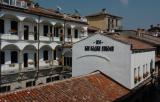Church St. Forty Martyrs
This church is the most famous medieval Bulgarian monument in Veliko Tarnovo. It was built and frescoed by the Bulgarian Tsar Ivan Asen II in honor of the great victory of the Bulgarians at Klokotnitsa over the troops of the Epirus despot Cyrus Theodore Comnenus on March 22, 1230. In the XIII-XIV centuries the church of St. Forty Martyrs was the main church of the Great Lavra Monastery, which was located at the foot of Tsarevets on the left bank of the Yantra. It was also a royal church during the reign of Ivan Assen II. In the years of Ottoman slavery, probably until the first half of the 18th century, the church remained Christian. With its transformation into a mosque, the frescoes, icons and iconostasis were destroyed.
Systematic archeological excavations began in 1969. Kaloyan's burial, discovered in October 1972, is of great interest. It is of a man, about 1.9 m tall, in rich military clothing, decorated with intricate embroidery with woven gold tinsel and pearls, on his hand with a preserved massive gold ring seal weighing 61.1 g, which has a heraldic image of a leopard and an inscription in negative: "Kaloyan's ring". A seal with the same heraldic sign was opened in 1981 - irrefutable proof of the coat of arms of the Bulgarians in the Asenovtsi dynasty.
Address: 22 St. Kliment Ohridski Str., 5000 Assenov, Veliko Tarnovo
Website: Church St. Forty Martyrs

















